The Best Flowering Vines to Grow in Northern California
If you are looking for flowering vines to grow in Northern California, you have come to the right place. In this blog post, we will discuss some of the best plants for the region. Keep in mind that different plants will thrive in different parts of Northern California, so be sure to do your research before planting anything.
Virgin’s Bower (Clematis ligusticifolia)
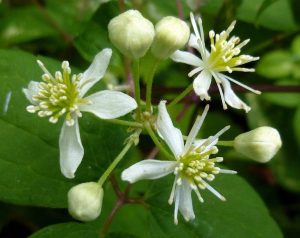
The Virgin’s Bower (Clematis ligusticifolia) is a deciduous climbing vine that is native to North America. It grows best in full sun to partial shade and prefers moist, well-drained soils. This fast-growing vine can reach up to 30 feet in length and produces fragrant, white flowers from June to September. The Virgin’s Bower (Clematis ligusticifolia) is a beautiful flowering vine that is easy to grow and maintain. It has large, white flowers that bloom profusely from late summer to early fall. The Virgin’s Bower is a fast-growing vine, so it is ideal for covering unsightly walls or fences. It is also tolerant of drought and poor soil conditions. The Virgin’s Bower is an excellent choice for those looking for a beautiful flowering vine that is easy to grow and maintain. Additionally, this vine is resistant to deer and rabbits, making it a good choice for gardeners concerned about pests.
Chaparral Clematis (Clematis lasiantha)
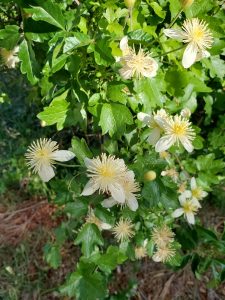
The Chaparral Clematis (Clematis lasiantha) is a clematis native to the western United States. It is a deciduous vine that grows to 6-10 feet in length and has dark green, leathery leaves. The flowers are white or cream-colored and have 4-5 petals. The blooming period occurs from June to August, and the flowers are followed by silver-gray seed heads. The Chaparral Clematis is adapted to dry, rocky habitats and is often found growing in chaparral or sagebrush ecosystems. It is a hardy plant that is resistant to drought and heat. This vine is a species of clematis that is native to the western United States. It is a deciduous vine that grows to 6-10 feet in length and has dark green, leathery leaves. The flowers are white or cream-colored and have 4-5 petals. The blooming period occurs from June to August, and the flowers are followed by silver-gray seed heads. The Chaparral Clematis is adapted to dry, rocky habitats and is often found growing in chaparral or sagebrush ecosystems. It is a hardy plant that is resistant to drought and heat. This makes it an excellent choice for xeriscaping or other water-wise gardening practices. The Chaparral Clematis can be propagated by seed or cuttings and can also be grown from root divisions. It is a fast-growing plant that does best in full sun to partial shade. It prefers well-drained soils but can tolerate sandy or clay soils as long as they are not too wet. Once established, the Chaparral Clematis is relatively drought tolerant but will produce more flowers if given regular watering during the hotter months of the year. This beautiful vine can add color and interest to any landscape, and its drought tolerance makes it an excellent choice for xeriscaping or other Waterwise gardening practices.
Chaparral False Bindweed (Calystegia occidentalis)

The Chaparral False Bindweed (Calystegia occidentalis) is a species of flowering plant in the morning glory family, Convolvulaceae. It is native to western North America and occurs in the chaparral and coastal sage scrub habitats of the southwestern United States and northwestern Mexico. The plant is a climbing or trailing vine that can reach up to 6 meters. The leaves are ovate-shaped with smooth margins, and the flowers are white or pale pink. The leaves are also oppositely arranged, and the flowers are white or pinkish-white in color. The fruit is a capsule that contains small black seeds. The Chaparral False Bindweed blooms from March to June. It is an important food source for bees and other pollinators. The Chaparral False Bindweed is considered a weedy species and can spread rapidly if it is not controlled. The Chaparral False Bindweed is highly adaptable and can grow in various habitats. It is often found in disturbed areas such as roadsides and parking lots. This plant is considered an invasive species in many parts of the world, including Australia, New Zealand, and parts of Europe.
American Vetch (Vicia americana ssp. americana)
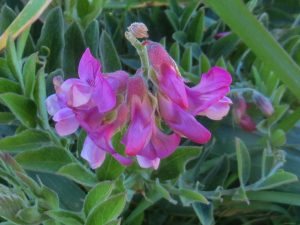
The American Vetch (Vicia Americana ssp. Americana) is an annual climbing herb in the legume family. It is native to North America and occurs in every state except Alaska. The plant grows upright to a height of 2-3 feet, with slender, branching stems covered in small, pubescent leaves. The leaves are compound, with 2-5 oval-shaped leaflets per leaf. The plant produces small, purple flowers that bloom in clusters from early summer to fall. The fruits are hairy, dark brown pods that contain 3-8 small, hard seeds. The American Vetch is a popular food source for many birds and mammals, and its seeds are often used as a winter food source by small rodents such as mice and voles. The plant is also an important nectar source for bees and other pollinators. In addition, the American Vetch’s deep roots help stabilize the soil and prevent erosion. American Vetch is a nitrogen-fixing plant, which means that it helps to improve the quality of the soil. It is often used as a cover crop or green manure and can also be grown for hay or forage. To grow American Vetch, simply sow the seeds in early spring. The plants will do best in full sun and well-drained soil. Be sure to provide plenty of water, as the plants will wilt quickly if they become too dry. With a little care, the American Vetch will thrive and provide your garden with beautiful color and valuable nutrients.
Stebbins’ Morning-glory (Calystegia stebbinsii)
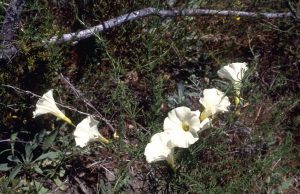
The Stebbins’ Morning-glory (Calystegia stebbinsii) is a species of flowering plant in the morning glory family. It is endemic to California, where it is known from the Sierra Nevada and the Coast Ranges. Botanist Lincoln Constance first described the plant in 1940. The species is named after botanist Robert Hugh Stebbins, who collected the type specimen.
The Stebbins’ Morning-glory is a perennial vine with twining stems. The leaves are arranged in opposite pairs and are broadly ovate to heart-shaped. They are 10–18 centimeters long and 8–15 centimeters wide. The flowers are white or pink, with six petals arranged in two rows of three. The fruit is a spherical capsule containing numerous black seeds.
The Stebbins’ Morning-glory occurs in forested and open habitats, including chaparral, woodlands, and meadows. It blooms from May to August.
The Stebbins’ Morning-glory is a beautiful vine that makes an excellent addition to any garden. It is easy to grow and is tolerant of a wide range of conditions. The vine will climb over fences, trellises, or other structures and can also be grown as a ground cover.
Graceful Bedstraw (Galium porrigens var. porrigens)
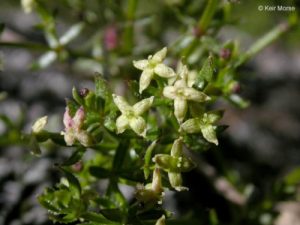
The Graceful Bedstraw (Galium porrigens var. porrigens) is a herbaceous perennial plant that is native to Europe. The leaves of the Graceful Bedstraw are lanceolate and measure 2-5 cm in length and 0.5-1.5 cm in width. The leaves are arranged in whorls of six to eight and are attached to the stem via short petioles. The flowers of the Graceful Bedstraw are white and have four petals that measure 1-2 cm in length. The flowers are borne in clusters of two to six and are pollinated by bees and other insects. The fruit of the Graceful Bedstraw is a cluster of brownish-black seeds that measure 0.5-1 cm in length. The seeds are dispersed by wind and water. The Graceful Bedstraw is found in damp meadows, woods, and hedgerows. The Graceful Bedstraw is a common plant on roadside verges, railway embankments, and other disturbed habitats in the United States. It prefers full sun to partial shade and well-drained soil. Once established, it is drought tolerant and does not require much care. To propagate, simply take stem cuttings in spring or fall. The Graceful Bedstraw is a lovely addition to any garden and makes an excellent ground cover. With its low-maintenance requirements and spreading habit, it is an ideal vine for beginner gardeners.
Hairy Honeysuckle (Lonicera hispidula)
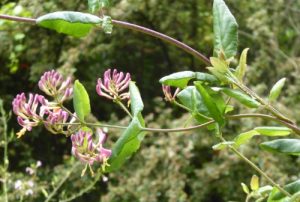
The Hairy Honeysuckle (Lonicera hispidula) is a deciduous shrub that is native to North America. It grows to be 3-6 feet tall and has oval-shaped leaves that are dark green with hairy undersides. It has erect, multiple stems with dark brown bark. The hairy leaves are opposite, ovate to oblong in shape, and have toothed margins. The small, tubular flowers are borne in clusters of 2-5 and are white with purple veins. The fruits are black berries that ripen in late summer and are favored by birds. The Hairy Honeysuckle prefers to grow in full sun or partial shade and moist, well-drained soils. It is tolerant of a wide range of soil types and pH levels. This shrub is also resistant to deer browse and drought. Seed, cuttings, or layering can propagate it. The Hairy Honeysuckle is an attractive shrub that can provide structure and interest in the garden. It is also a valuable food source for birds and other wildlife.
Poison Oak (Toxicodendron diversilobum)

Poison oak (Toxicodendron diversilobum) is a shrub or small tree in the sumac family, Anacardiaceae. It is native to western North America and widespread from British Columbia to southern California. Poison oak is a highly variable plant with many subspecies and varieties. It typically grows to 1-5 m (3-16 ft) tall but can reach up to 10 m (33 ft) in some cases. The leaves are alternate, compound, and usually have 3-9 leaflets. The leaflets are ovate to lanceolate in shape and are 2-8 cm (0.8-3.1 in) long and 1-4 cm (0.4-1.6 in) wide. The leaf surfaces are either glabrous or pubescent, and the edges are serrate or dentate. The leaves turn red or orange in autumn before falling off the plant. The flowers are small and inconspicuous, with greenish-white petals that measure 2-3 mm (0.08-0.12 in) long. The fruit is a small drupe that is 4-8 mm (0.16-0.31 in) in diameter and contains one or two seeds. All parts of the plant contain urushiol, a toxin that can cause an allergic reaction in humans if it comes into contact with the skin. Poison oak is commonly found throughout its range in woodlands, chaparral, and coastal areas. It often forms dense stands that crowd out other plants and can make hiking through certain areas difficult. Ingestion of the berries can cause vomiting and diarrhea in humans, and contact with the leaves or stems can result in severe dermatitis.” While it may not serve humans any purpose, the vine can contribute to the ecosystem by preventing infestation by some pests and diseases.
Rough Fruit Berry (Rubus lasiococcus)

The Rough Fruit Berry (Rubus lasiococcus) is a member of the rose family and is native to North America. The plant typically grows to be about 1-2 meters tall and has stout, thorny stems. The leaves are simple and palmately lobed, with 3-5 lobes per leaf. The flowers are white or pink and borne in clusters of 3-5. The berries are small, spherical, and dark red in color. They grow in clusters on thorny shrubs and ripen from summer to autumn. The berries are edible but are quite tart and not particularly palatable raw. However, they can be used in jams, pies, and other baked goods. The Rough Fruit Berry plant leaves are also edible and can be used as a substitute for spinach or other leafy greens. To grow Rough-Fruit Berry, plant the seeds in well-drained soil in full sun to partial shade. The plants are tolerant of a wide range of soils but prefer loamy or sandy soil that is slightly acidic. Flowers will appear in the second year after planting. Berries will mature in the third year. To harvest the berries, wait until they are fully ripe and then cut them from the stem with pruning shears. Be sure to wear gloves when handling the plants, as they can cause skin irritation.
Wild Cucumber (Marah oregana)
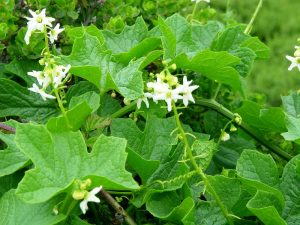
The Wild Cucumber (Marah oregana) is a scrambling vine that typically grows to about six feet in length. The leaves are dark green and glossy, with sharply toothed edges. The stems are also dark green and slightly hairy. The flowers are small and white, with five petals arranged in a star shape. The fruit is a green, cucumber-like capsule that contains numerous seeds. When ripe, the capsule splits open to release the seeds. Wild Cucumbers are found throughout the western United States, from California to Colorado. They prefer sunny locations with well-drained soil. This plant is often found growing in gardens, where it can be an attractive addition. However, it can also become invasive if left unchecked.
Conclusion
Many different types of flowering vines can be grown in northern California. These plants can provide structure and interest in the garden and are a valuable food source for birds and other wildlife. When choosing a vine to grow in your garden, it is important to select one that is appropriate for your area’s climate and soil type. It is also important to consider the uses that you will have for these vines before deciding on a species to grow.

